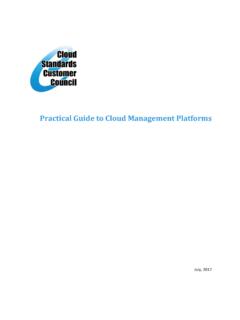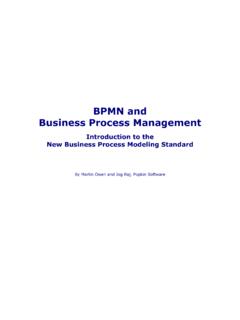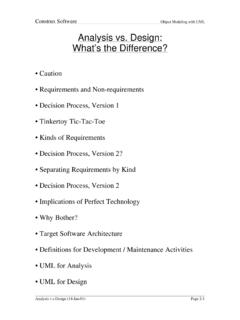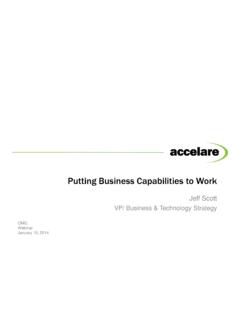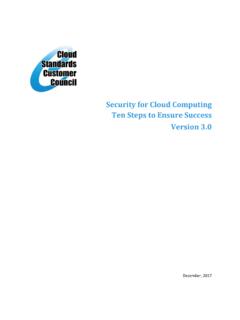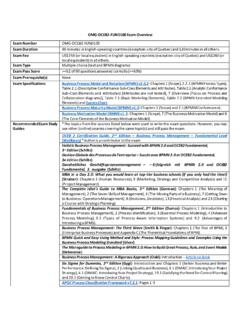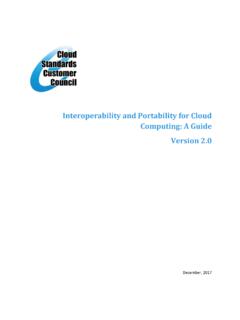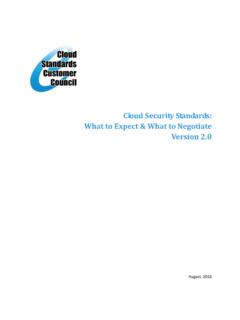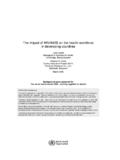Transcription of Migrating Applications to Public Cloud Services: Roadmap ...
1 Migrating Applications to Public Cloud Services: Roadmap for Success Version February, 2018 Copyright 2018 Cloud Standards Customer Council Page 2 Contents Acknowledgements .. 3 Executive Overview .. 4 Motivation and Considerations .. 5 Migration Roadmap .. 6 Step 1: Assess your Applications and Workloads .. 7 Step 2: Build a Business Case .. 10 Step 3: Develop a Technical Approach .. 13 Step 4: Adopt a Flexible Integration Model .. 18 Step 5: Address Compliance, Security, Privacy and Data Residency Requirements .. 20 Step 6: Manage the Migration.
2 23 Appendix A: Examples of Cloud -ready Workloads .. 26 Appendix B: Application Migration Tasks - Example .. 29 Appendix C: Bibliography .. 37 Copyright 2018 Cloud Standards Customer Council Page 3 2018 Cloud Standards Customer Council All rights reserved. You may download, store, display on your computer, view, print, and link to the Migrating Applications to Public Cloud Services: Roadmap for Success Version (2018) white paper at the Cloud Standards Customer Council website, subject to the following: (a) the document may be used solely for your personal, informational, non-commercial use; (b) the document may not be modified or altered in any way; (c) the document may not be redistributed; and (d) the trademark, copyright or other notices may not be removed.
3 You may quote portions of the document as permitted by the Fair Use provisions of the United States Copyright Act, provided that you attribute the portions to the Cloud 0 Standards Customer Council s Migrating Applications to Public Cloud Services: Roadmap for Success Version (2018). Acknowledgements The major contributors to this white paper are: Claude Baudoin (c b IT & Knowledge Management), Chris Carlson (Retriever Consulting), Giuseppina Cretella (Second University of Naples), Beniamino Di Martino (Second University of Naples), Mike Edwards (IBM), Shamun Mahmud ( Cloud Security Alliance), John McDonald (ClearObject), John Meegan (IBM), Sujatha Perepa (IBM), Keith Prabhu (Confidis), Ram Ravishankar (IBM), Michael Salsburg (Unisys), Muralidhar Seelam (IBM) and Joe Talik (NEORIS).
4 Additional contributors to Version are Christian Boudal (IBM), Steve Cirian (IBM), Ash Heda (Wipro), George Malekkos (PowerSoft), Nya Murray (Trac-Car), Bill Parker (Aspen Solutions), Srinivasa Reddy Karri (Schlumberger), Karolyn Schalk (IBM), Lisa Schenkewitz (IBM), Sri Shetty (IBM), and Prasad Siddabathuni (Edifecs). Copyright 2018 Cloud Standards Customer Council Page 4 Executive Overview Across all industries, discussion of migration to Cloud services have become commonplace. In fact, it is one of the first considerations when discussing IT cost reduction.
5 While cost savings, speed of deployment and scalability top the list of business motivations, an increasing number of enterprises also view Cloud computing as a key enabler of business transformation one that can help improve customer engagement, forge new partnerships and drive competitive advantage while ensuring compliance with standards and future-proofing solutions. However, the migration of Applications to Cloud computing must be done in a strategic and methodical manner. Existing enterprise Applications must be thoroughly assessed to determine which workloads can benefit most from early migration to the Cloud .
6 Cloud customers must take into account the costs of migration, the potential need for application redesign, longevity, performance and availability, security and privacy requirements, the selection of locations, and other potential regulatory requirements. Moreover, the relative importance of these considerations may vary over time, and users should think of them over the long term. The aim of this guide is to provide a practical reference to help enterprise information technology (IT) and business decision makers analyze and consider application migration to the Cloud .
7 The paper focuses primarily on the migration of Applications to Public Cloud services, although the increasing adoption of hybrid Cloud architectures (discussed in detail in another CSCC white paper) makes this guide relevant to such situations. The guide includes a sequence of steps, along with guidance and strategies, that take into consideration both business and technical requirements. An enterprise strategy for Cloud computing must identify individual business problems with existing Applications that Cloud computing can potentially address and provide specific business justification that the Cloud is the right strategic alternative.
8 The section titled Motivation and Considerations provides an overview of the potential impact that the migration of enterprise Applications to Cloud computing will have on new and existing business processes, and guidance on the types of Applications that are best suited for migration. A business case for Migrating Applications to the Cloud must consider the current state of both the Applications and the infrastructure, and evaluate the ability of Cloud computing to support the enterprise strategy and deliver meaningful business value. In most cases, Applications are moved in move groups, which are based on qualifying criteria that assess them as having minimal, low, medium, or high impact to the enterprise.
9 Starting small and expanding after initial success is usually the most prudent approach to application Cloud migration. The section titled Migration Roadmap is the heart of the guide and includes the basic steps of a formalized migration process. It details both strategic and tactical activities for decision makers to develop a business plan and detailed migration plan. Copyright 2018 Cloud Standards Customer Council Page 5 Motivation and Considerations The business community might have the following motivations for the migration of an application to the Cloud .
10 Greater scalability Making access easier by a mobile workforce Business agility, collaboration and flexibility Improved security Better analytics on application usage Reduced software maintenance effort Improved availability and responsiveness Improved compliance with laws and regulations ( , on privacy, data residency, or trade compliance) Reduced and/or re-allocated infrastructure costs Most of these objectives are well matched by key Cloud computing characteristics: Rapid elasticity. The ability to rapidly scale the IT infrastructure (up or down) to match changing requirements, on a pay-per-use basis, is extremely attractive to large and small organizations alike.
